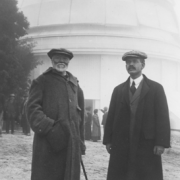- 1610: Galileo
- 1676: Ole Rømer
- 1687: Isaac Newton
- 1781: William Herschel
- 1838: Friedrich Bessel
- 1861: William and Margaret Huggins
- 1912: Henrietta Leavitt
- 1917 Einstein
- 1920: Harlow Shapley
- 1929 Edwin Hubble
- 1948: Ralph Alpher
- 1949: Fred Hoyle
- 1963: Maarten Schmidt
- 1964: Arno Penzias and Robert Wilson
- 1978: Vera Rubin and Kent Ford
- 1989: Margaret Geller and John Huchra
- 1992: John Mather and George Smoot
- 1995: Robert Williams
- 1998: Saul Perlmutter and Brian Schmidt
- 2010: Wendy Freedman
60-Inch Reflecting Telescope
 |
| Andrew Carnegie (left) and George Ellery Hale stand in front of the dome of the 60-inch telescope at Mt. Wilson in 1910. Image courtesy of The Observatories of The Carnegie Institution for Science and The Huntington Library. |
The 60-inch telescope was the first of the really large reflecting telescopes of the 20th century. Since large glass lenses would distort due to their own weight, only mirrors would be used for large telescopes from this point forward. Bigger telescopes had two advantages over small telescopes, making them idea for investigating the nebulae: they could be used to observe and photograph fainter objects, and they could image those objects in greater detail. Shapley used the telescope to study a certain type of nebula, called “globular clusters” in great detail.
The 60-inch telescope at Mount Wilson was the brainchild of George Ellery Hale, who was an astronomer with a passion for bigger and better telescopes, and a gift for persuading wealthy men to support such projects. Here he is pictured with Andrew Carnegie whose estate continues to support astronomy through such institutions as the Carnegie Institution for Science.